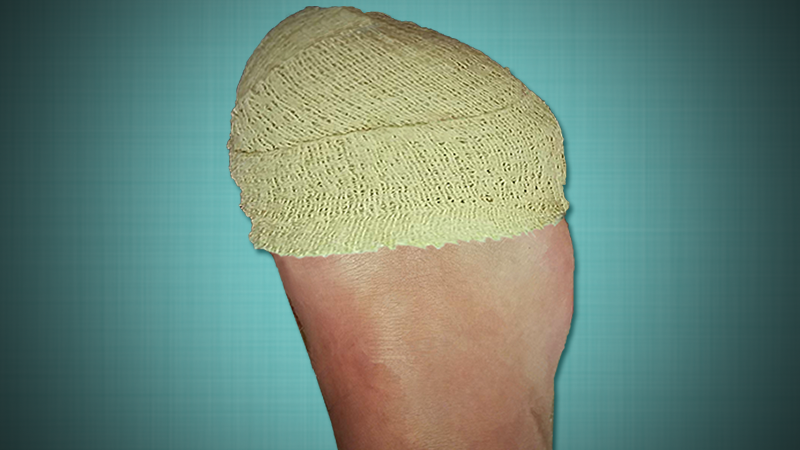
Practice Perfect 754
Should We Cover the Toes During Lower Extremity Surgery?
Should We Cover the Toes During Lower Extremity Surgery?

I was watching an online surgical video about ankle fractures the other day and noted that the surgeons had covered the toes with Coban. As someone who has never covered the toes for any procedure, my first thought was, “What a waste of time.” But the questioning side of my mind couldn’t help but ask the counter question: “Is covering the toes really a waste of time?”. Does it lower the risk of post-operative infection? What does the research evidence show?
After a quick search, the surgical literature consists of papers that utilize two primary methods: culture results (the majority of papers) and clinical outcomes. In the first method, researchers culture the toes before and after surgery, while the second method examines infection rates with the toes covered versus not. Take a look at Table 1 for a quick summary of the studies that examined the first method.
Table 1. Studies of bacterial contamination after preoperative preparation in foot and ankle surgery.
| Study | Method | Outcome |
|
Ostrander, et al1 |
RCT, 50 patients
Grp 1: 25 patients povidone-iodine prep. Grp 2: 25 patients iodophor prep + povidone-iodine paint. Cultures immediately after prep and drape. |
“Numerous pathogens were cultured.” |
|
Hort & DeOrio2 |
RCT, 49 patients Povidone iodine vs povidone iodine + 70% alcohol prep. Cultures immediately after prep and drape. |
9 of 26 (35%) patients + cultures 1st group. 13 of 23 (57%) + cultures 2nd group. No postop infections or wound problems. Conclusion: incompletely sterile field, alcohol didn’t help. |
|
Brooks, et al3 |
50 patients randomized to 2 groups. Grp 1: 26 patients standard prep (povidone-iodine + alcohol) + extra swabbing between toes. Grp 2: 24 patients with standard prep Cultures immediately after prep and drape. |
4% overall culture rate after prep. Grp 1: 7.7% culture + Grp 2: 20.8% culture + 3/50 patients had postop infection (none with the organism that were initially cultured). |
Now, on the surface, after reading these you might think you should cover the toes. However, the problem with these studies is bacterial colonization after prep is being used as a proxy for infection. This is the problem with research studies with indirect methodologies; the conclusions may not answer the clinical question. Contamination does NOT equal infection. In fact, this is supported by both Hort and DeOrio’s and Brooks’studies2,3 where despite a high level of contamination after prep, they did not have postoperative infections.
What if we had a higher quality study that directly compared covering the toes versus leaving them uncovered and quantifying the postoperative infection rate? That might give us more directly applicable answers, and we do in fact have that study!
Groucher and Coughlin4 randomly assigned 40 foot and ankle surgery patients to either covering the forefoot with a sterile glove or leaving the forefoot uncovered. Three culture samples were taken (before prep, just after prep and drape, and at the end of surgery). The prep itself was with chlorhexidine gluconate and 70% isopropyl alcohol. Before surgery 35 of 40 (87.5%) were culture positive. One patient was culture positive at the end of surgery but not after initial prep. One patient was culture positive on all three samples. Neither patient had a postoperative infection. The authors’ conclusion was, “The results of this study indicate no benefits in covering the toes in hindfoot or ankle surgery.” Methodologically, this is the best study available to date to answer our question.
It appears that covering the toes doesn’t matter.
Given this data, we can conclude it is impossible to completely sterilize the foot with contemporary methods, but the residual bacterial contamination does not translate to postoperative infections. It appears that covering the toes doesn’t matter.

-
Ostrander RV, Brage ME, Botte MJ. Bacterial skin contamination after surgical preparation in foot and ankle surgery. Clin Orthop Relat Res. 2003 Jan;406(1):246-252.
Follow this link -
Hort KR, DeOrio JK. Residual bacterial contamination after surgical preparation of the foot or ankle with or without alcohol. Foot Ankle Int. 2002 Oct;23(10):946-948.
Follow this link -
Brooks RA, Hollinghurst D, Ribbans WJ, Severn M. Bacterial recolonization during foot surgery: a prospective randomized study of toe preparation techniques. Foot Ankle Int. 2001 Apr;22(4):347-350.
Follow this link -
Goucher NR, Coughlin MJ. Covering of the toes during hindfoot and ankle surgery: a randomized, controlled, clinical study. Foot Ankle Int. 2007 Apr;28(4):413-415.
Follow this link




























Comments
There are 0 comments for this article